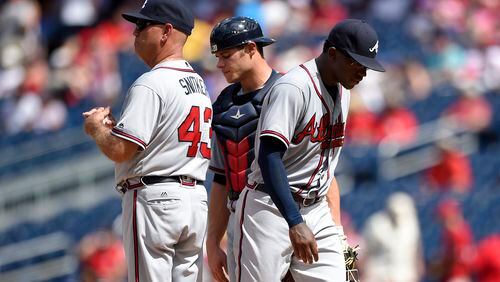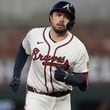Tyrell Jenkins just became the third of the Atlanta Braves' lovingly assembled young pitchers -- the third in two months -- to be demoted to Class AAA after being installed in the major-league rotation. As we know, the path of a young pitcher is seldom straight and true. Still: Three in two months?
We stipulate that Jenkins didn't arrive with quite the same close-to-the-majors billing as Matt Wisler or Aaron Blair. He was the ride-along in the first Shelby Miller trade -- the one to get Miller, not dispatch him -- and the Braves liked his arm. They still do. But we've just seen why his promotion to the majors was as a reliever: He's essentially a fastball/changup guy.
According to Brooks Baseball, he threw 694 four-seamers, two-seamers and changeups in his 49 1/3 big-league innings. He threw 134 curveballs -- he has one; the issue is controlling it -- and 20 sliders. Generally speaking, you need three reliable pitches to make it as a starter.
On his first time through the order, he threw his four-seamer 53 percent of the time; the third time around, he threw it 34 percent, having increased his changeup usage from eight percent to 27 percent. On that third time, assuming he made it that far, opponents hit .600 against his curve.
The first time through, opponents' OPS versus Jenkins was 1.042 , which is bad. The second time was better -- .679. The third was even worse -- 1.061. By then, batters had seen what he had and were teeing off. He yielded five home runs on the first and second times through the order; he yielded four on the third.
The final straw actually came on the Nationals' second time around, though it extended into the third. In the fourth inning Friday, Jenkins -- holding a 3-1 lead -- yielded eight earned runs on seven hits and a walk. It went thusly: Homer, walk, F-9, single, single, single, single, homer, single.
(Aside: Would you have left a young pitcher in the game after the second homer of what was already a six-hit inning?)
OK. So Jenkins-as-starter didn't work, even though he had a run of three consecutive quality starts before getting touched for 16 earned runs in eight innings against Washington. He might well be suited to relief. (Though he doesn't break 95 mph with his fastball, which is the new baseline for relievers.) Were it just Jenkins, pressed into starting service because others had fizzled or been hurt, we'd say, "No big deal."
But Wisler, who was promising if not overwhelming as a big-league starter last year, got worse the more he worked in Year 2. (Per Baseball-Reference, h is ERA as of June 1 was 3.16 . As of July 1, it was 4.14. As of July 28, it was 5.16.) Blair, considered almost big-league ready when the Braves acquired him in the second Miller trade, came up in April, was sent back and then recalled -- and was awful the whole time. (In 50 2/3 innings, he had 29 strikeouts against 29 walks .)
That three promising pitchers were demoted with apparently healthy arms is good in that they're not headed for Tommy John surgery, as so many Braves pitchers have been over time. That three promising pitchers were demoted simply because they'd stopped getting people out is worrisome: Was there something the Braves could have done -- some mechanical tweak -- to keep them at the big-league level?
I've mentioned this before , but what success Roger McDowell has had as a pitching coach -- and he has had some great successes -- has tended to come with guys who've been around and can execute a game plan. (Everyone agrees that McDowell is an ace among game-planners.) But planning doesn't matter if a pitcher's mechanics are flying off into the ether or if he's throwing the wrong pitches.
Since McDowell replaced Leo Mazzone after the 2005 season, the Braves have had some excellent starting rotations -- and lockdown bullpens, too -- while taking only one hotshot prospect and turning him into a big-league No. 1 or No. 2. Julio Teheran is the exception , and his dominance this season came after a wobbling 2015 that saw him relying on his two-seamer, which was always his third-best pitch. (A two-seamer is a sinker. McDowell was a famous sinkerballer.)
Maybe Kris Medlen would have been another prospect-to-ace, but he had two rounds of Tommy John surgery in four calendar years. Brandon Beachy, who was leading the National League in ERA in June 2012, had two TJs in two years. As Will Carroll, a writer who tracks baseball injuries, said last year: " You almost never see a guy having a second Tommy John inside five years, and they had two … What more sign from the heavens do you need?"
Also from Carroll : "They've been good at finding them and getting them to (the major-league) level. They've had super prospects (such as Tommy Hanson and Mike Minor) — they get there, and then they break ... I don't like to point the finger from outside, but everything's pointing to Roger McDowell."
Per Jon Roegele's invaluable spreadsheet, we note that f our players in the Braves' organization have had the procedure over the past 15 months . One is Zach Becherer, a high schooler the Braves drafted in June knowing he'd just had TJ; another is Paco Rodiguez, who was acquired in the Wood/Peraza/J. Johnson/Avilan trade of last July and was nursing a sore arm even then. (The other two: Reliever Andrew McKirahan, whom the Braves claimed off waivers in 2015, and minor-leaguer Dalton Geekie, a Round 22 pick last year.)
In the era of TJ, four in 15 months -- with one and perhaps two being inherited cases -- isn't awful. This could mean that the Braves' screening and monitoring of deliveries under John Coppolella and John Hart has had some effect. It could just mean that they've been lucky. (With Tommy John, nobody knows anything.) The good news is that the Braves, who've collected a slew of young pitchers in the past two years, have mostly kept them healthy. Knock on wood.
The less-glad tidings: So far, the Braves haven't found a starting pitcher who has proved he can stick in a rotation. (Mike Foltynewicz has the stuff, but his pitch counts run so high -- over 100 in seven of his past eight starts, the exception being a 99-pitch game -- that he rarely works past the sixth inning.) Granted, it's early days. We haven't seen Sean Newcomb or Touki Toussaint or Max Fried or Kolby Allard or Mike Soroka, to say nothing of Ian Anderson and Joey Wentz or Kyle Muller. All hope is not yet lost.
As Hart said last summer, quoting the baseball adage regarding pitchers: "You need 10 to get three." As it stands, we can't say for sure that the Braves have found even one.
Further reading: Andruw Jones belongs in a bigger Hall of Fame. (Meaning Cooperstown.)
About the Author







